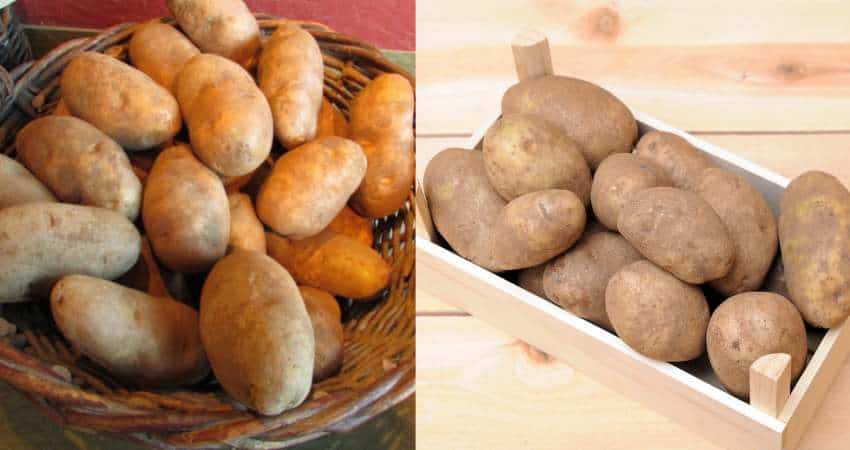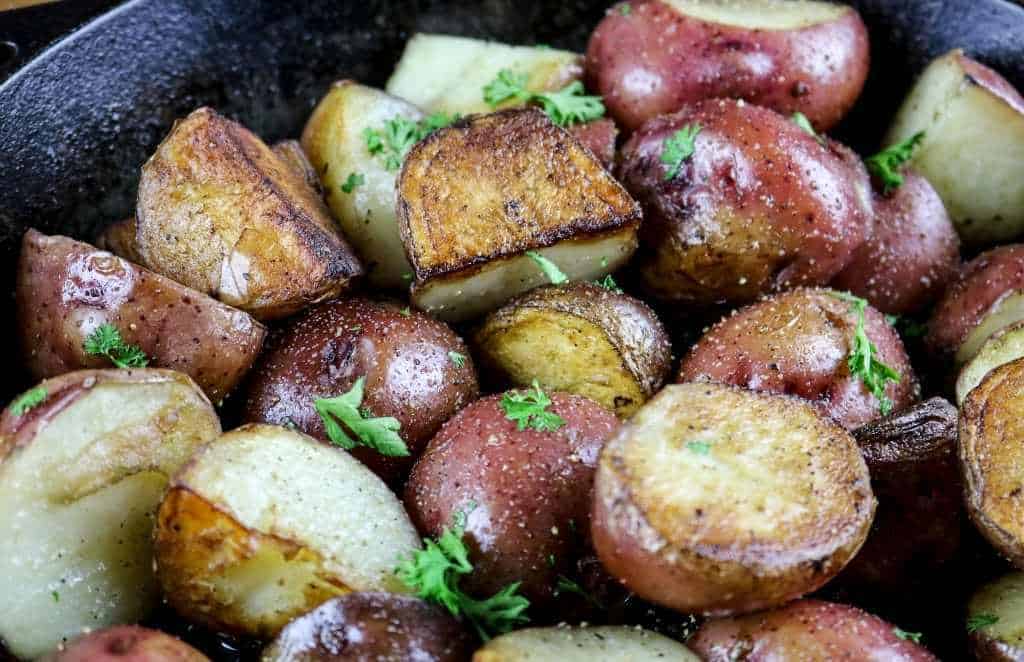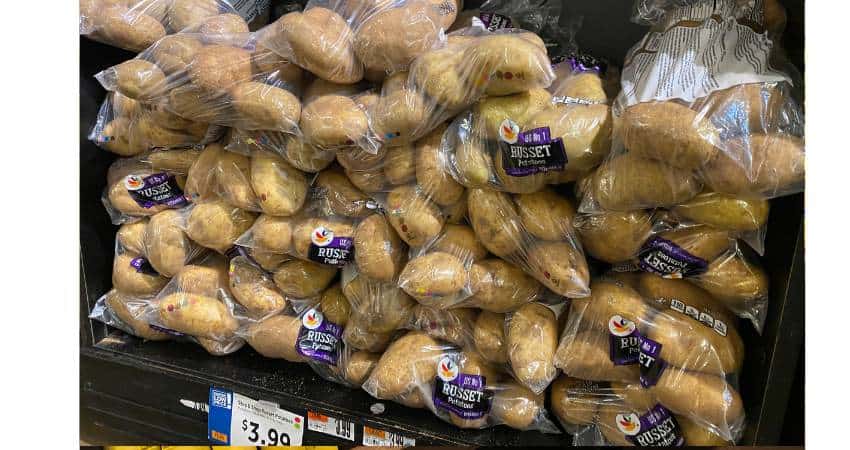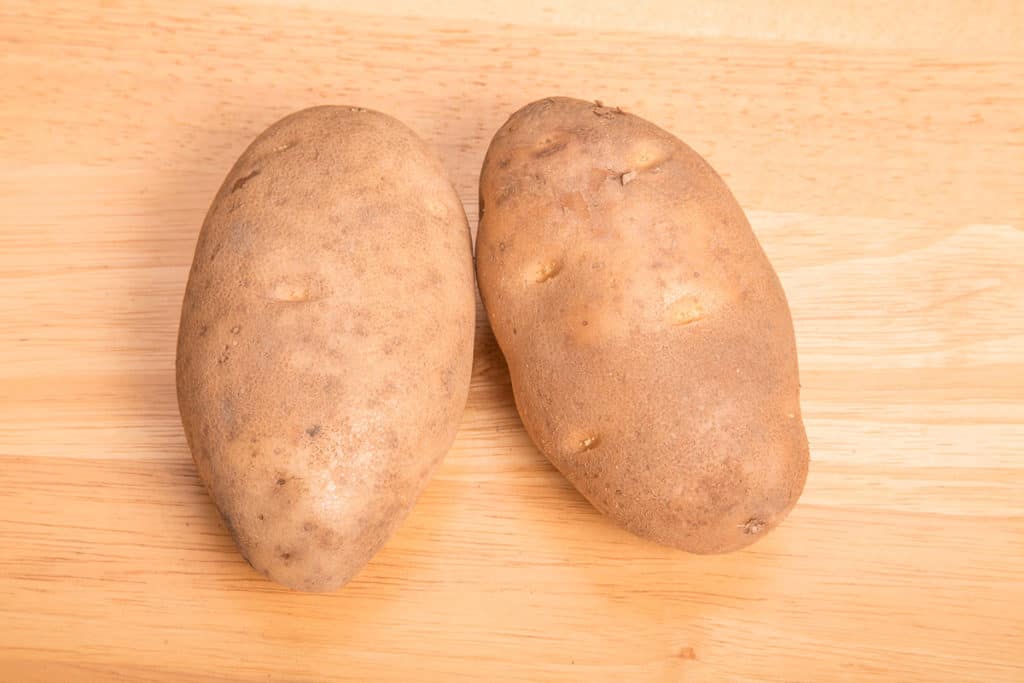Idaho vs Russet Potatoes – Are Idaho Potatoes The Same?
During my health coaching sessions many clients ask about potatoes. Many people call Russet potatoes Idaho, causing some to ask if they’re the same. Let’s answer, are Idaho and Russet potatoes the same?
Idaho potatoes refer to any potato variety grown in the State of Idaho which may include Russet. Russet potatoes are a variety which can be grown anywhere including Idaho. Popular Idaho varieties include Russet, Yukon Gold, Reds and Fingerlings.
This means that Idaho potatoes can be Idaho Russet potatoes, but not all Russet potatoes are Idaho potatoes. Some Russet potatoes can be grown in other States. In this article, we’ll examine their tastes, textures, what they can be used for, nutrients and costs.
In addition to coaching clients about them, I’ve purchased, researched and consumed both prior to, during and after writing this article.

What Kind of Potato is an Idaho Potato?
Idaho potatoes refer to 30 different potatoes grown in Idaho State. Idaho potatoes are certified with the “Idaho Potato” or the “Grown In Idaho” seal which can be found on the packaging. The seal ensures consumers are purchasing ones grown only in Idaho.
The following are the most popular varieties grown in Idaho:
- All Blue
- Alturas Russet
- Ama Rosa
- Bannock Russet
- Bintje
- Blazer Russet
- Cal Red
- Classic Russet
- Clearwater Russet
- French Fingerling
- Huckleberry Gold
- Ida Rose
- Milva
- Norland
- Premier Russet
- Purple Passion
- Purple Peruvian
- Ranger Russet
- Red La Soda
- Red Thumb Fingerling
- Ruby Crescent
- Russet Burbank
- Russet Norkotah
- Russian Banana
- Terra Rosa
- Umatilla Russet
- Western Russet
- Yellow Finn
- Yukon Gem
- Yukon Gold
All the potatoes exported from Idaho farms are labeled with a federally reserved certification mark indicating it was grown in Idaho. The marks include the phrases “Idaho Potato” or “Grown in Idaho” with a registered trademark symbol.
The purpose of the certifications is to protect the Idaho brand, which is one of the leading drivers of the economy in the State and an integral part of United States farming and food production.
The certification marks belong to the Idaho Potato Commission. It makes the buyer aware of two different types of potatoes which otherwise may have seemed the same.
Why is an Idaho Potato the Best?
Idaho potatoes are the best due to Idaho’s environment perfect for potato growing. The air and water are clean, and the climate is chilly. The days are warm and the nights are cool. The soil has rich volcanic residue since the area is surrounded by mountains providing ideal irrigation.
Idaho is known as the potato capital of the United States.
Every year, nearly 30% of potatoes in the United States are grown in Idaho, which averages to about 13 billion pounds. The first crops were brought to Idaho in the 1830s by a missionary named Henry Spalding.
Most are grown in Eastern Idaho where there’s the most room and best soil for them to thrive. It’s one of the biggest potato-growing areas in the world.
The most popular potato grown in Idaho is in fact a russet, which is the most well-known potato variety. Besides the russet, there are other varieties grown in Idaho. This is why the Russets grown in Idaho are trademarked Idaho potatoes.
However, not every russet is an Idaho potato.

What is a Russet Burbank?
Russets are also commonly known as the Russet Burbank or a Burbank potato. The variety was developed by Luther Burbank in Massachusetts in the late 1800s. It was actually developed accidentally when Burbank used a cultivar while growing potatoes.
The russet potatoes are preferred and one of the most easily identifiable potatoes. It’s usually in an oval shape with rough brown skin. It is the type of french fries, mashed potatoes and baked potatoes are cooked from. They aren’t commonly used to make potato chips, however.
A Russet is high in vitamins B6 and C, carbohydrates and starch. It is also high in potassium. It’s naturally low in sodium and saturated fats but hold on to a lot of salt when cooked.
You can confirm a russet is from Idaho by checking for the trademark in your local grocery store or farmers’ market. If it doesn’t say it’s from Idaho, it’s not an Idaho russet potato. More than likely, that particular Russet was grown in another State.
The Differences Between the Russet Potatoes
Idaho Russets are ones grown in the State of Idaho. A Russet potato can be grown in Idaho or in another state.
Essentially, there’s not a difference between the potatoes because they can be the same thing. Idaho potatoes simply mean the potato was grown in Idaho, which encompasses any Russet potato grown in the state.
Russets actually make up about 81% of all harvested Idaho potatoes every year.
There are multiple types of Russet harvested each year inside and outside of Idaho. Some varieties include Burbanks, Norkotas and Ranger. Burbanks are the most popular, which we discussed previously as they’re named after the founder Luther Burbank.
Find out how plantains compared in taste and texture in my article.
What Things Make an Idaho Potato Taste Better
A Russet not grown in Idaho may not be of the same quality as the ones grown in the state. This has to do with the climate and soil of the individual farm or region. Ones from Idaho tend to taste better, which is why so many shoppers opt for them over other brands.
As we mentioned previously, the soil in Idaho’s farming region contains leftover volcanic material due to the mountainous region surrounding it. Furthermore, the air is warm during the day and cool at night, which is the ideal growing temperature.
When potatoes are exposed to too much cold air, they begin producing sugar which changes the taste. This is why they may taste too sweet sometimes. On the contrary, too much cold air isn’t good for any type of crop.
A crop might fail if the weather is exceptionally cold for the season. All varieties should ideally be kept in temperatures between 55℉ and 60℉.
Find out how rice nutritional values compared in my article here.
Idaho Potato vs Russet Potato: Taste and Texture
Idaho Russet potatoes taste more starchy and are low in moisture content. They have a mild, neutral flavor which is unsweet. The flesh is creamy while the skin is thicker and tougher to bite through.
This makes them taste so good compared to other potatoes. These qualities also improve how they are cooked.

What Idaho Potatoes are Good For
They are often used for favorite dishes like mashed potatoes, french fries, baked potatoes, or even scalloped potatoes.
A russet is also good for roasting, baking, mashing, scalloped and French fries.
I was interested in finding out how many people preferred the taste of Idaho vs Russet potatoes. I decided to conduct a poll of readers, clients and people from some food groups I belong to.
I asked the question, which one do you prefer the taste of?
- 85% said they preferred the taste of Idaho Russets
- 12% said they preferred the taste of a regular Russet
- 3% said they had no preference.
To conduct more original research, I thought it would be fun to conduct my own taste test at home. We prepared mashed potatoes of each type and seasoned them exactly the same way.
Nobody was aware which mashed was made from what potato. Out of four people the vote was split down the middle with no winner.
The video below explains one of the best Russet potato recipes.
Russet Potatoes Cost
With the rising prices of food, the cost of items certainly matters to most people. The price may sway your decision about which one to use. Therefore, let’s take a close look at which one costs more.
Idaho Russets costs more than Russet. Russet potatoes average cost is $0.99 per pound for loose, large potatoes. Idaho Russets cost $1.49 per pound.
To conduct some research, I decided to visit a few local supermarkets to check the prices of each one.
First I visited the Shoprite supermarket:
- Russet
- $0.99 per pound
I also checked Walmart:
- Russet
- $0.98 per pound
- Organic Idaho Russet potatoes
- $1.49 per pound
I then checked Stop & Shop:
- Russet potatoes
- $0.69 per pound

Find out how turnips compared to potatoes in my article here.
How to Store Russet Potatoes
How to properly store potatoes may make a difference when choosing one over the other. If you have both and routinely buy one or the other, you’ll want to know how to store them for longevity and quality.
Therefore, let’s examine how to store each one.
Store Idaho Russet potatoes or Russet potatoes the same way, in a dark place away from heat. Both should be kept out of the refrigerator. A humid basement is the best area. They should be kept in a burlap bag, basket or ventilated container and stored between 55°F and 60°F.
Storing them in a refrigerator can change the cell structure, make the center hard and diminish the flavor. If you don’t have a cool basement, be sure to store them in a ventilated place, away from heat and light.
Find out how they compared to red in my comparison article.

Glycemic Index
Knowing the glycemic index of any food is important especially if blood sugar levels are a concern. Blood sugar levels are an important thing people should be aware of, diabetic or not.
The Glycemic Index (GI) is a scale measuring how fast a particular food raises the blood sugar in the blood1. High blood sugar can lead to health complications with the kidneys, nerves, heart and eyes2.
Foods on the GI scale are categorized as:
- Low-GI foods: 55 or under
- Medium-GI foods: 56-69
- High-GI foods: 70 or over
How blood sugars levels are affected:
- Foods with a glycemic index 70 or more cause a more quicker spike in blood sugar levels.
- Foods with a glycemic index 56 to 69 cause a moderate spike in blood sugar levels.
- Foods with a glycemic index 55 or less cause a slow spike in blood sugar levels.
Now we know what GI is, and how it affects blood sugar, let’s find out which one has a higher GI.
Idaho Russet potatoes and Russet potatoes have a similar medium to high GI depending on the cooking method used. A boiled russet has a GI of 54, and a baked russet has a GI of 111.
Not every white potato has an equal GI. Idaho, Russet and other white potatoes all have different GI scores. In addition to how it is cooked, the heat of it when eaten affects the GI.
A study published in the Journal of the Diabetic Association found boiled potatoes eaten cold had a GI score of 56. When eaten hot it had a GI score of 893.
Nutrition Values
The following table is a side-by-side comparison of the nutrients:
| Idaho Russet Potato Raw (100 g) | Russet Potato Raw (100 g) | |
| Calories | 74 | 79 |
| Protein | 2.03 g | 2.14 g |
| Carbohydrates | 17.6 g | 18.1 g |
| Fiber | 1.4 g | 1.3 g |
| Fat | 0.05 g | 0.08 g |
| Sugar | 0.68 g | 0.62 g |
| Vitamin A | 0 IU | 1 IU |
| Beta-carotene | 0 mcg | 0 mcg |
| Vitamin C | 18.2 mg | 5.7 mg |
| Vitamin B6 | 0.13 mg | 0.34 mg |
| Vitamin B9 (Folate) | 11 mcg | 14 mcg |
| Vitamin B1 (Thiamin) | 0.07 mg | 0.08 mg |
| Vitamin B2 (Riboflavin) | 0.02 mg | 0.03 mg |
| Vitamin B3 (Niacin) | 1.08 mg | 1.04 mg |
| Vitamin B5 (Pantothenic Acid) | 0.3 mg | 0.3 mg |
| Magnesium | 16 mg | 23 mg |
| Phosphorous | 41 mg | 55 mg |
| Potassium | 419 mg | 417 mg |
| Iron | 0.73 mg | 0.86 mg |
| Copper | 0.05 mg | 0.10 mg |
| Calcium | 14 mg | 13 mg |
| Zinc | 0.2 mg | 0.3 mg |
| Manganese | 0.15 mg | 0.15 mg |
Both of them provide a variety of minerals and vitamins. At first glance it may be difficult to determine which one is healthier. Let’s take a close look at which one is healthier.
Idaho Russet potatoes are healthier than Russet potatoes due to its higher percentage of vitamin C. They contain 220% more vitamin C per 100 grams than regular Russets. Idaho Russet provides 18.2 mg of vitamin C per 100 grams, and regular Russets provide 5.7 mg.
The vitamin C is what gives the Idaho Russet potato the slight edge. All the other vitamins and minerals are very similar between the two types, and most people can’t go wrong choosing either one.
Find out how white sweet potatoes compared in my comparison article here.
Health Benefits
Potassium
Both of them provide a good amount of potassium. It helps the body get rid of excess sodium reducing fluid build-up. These help keep systolic and diastolic blood pressure lower ((American Heart Association: How Potassium Can Help Control High Blood Pressure)).
According to Harvard Health, a number of studies have shown a connection between low potassium levels and high blood pressure7. The more potassium, the more sodium your body will lose.
Consuming too much sodium or not enough potassium throws off the delicate balance the kidneys need to remove the excess water8.
Fiber for Digestion and Gut Health
They both contain fiber. Fiber remains in the digestive tract and provides gut related health benefits. Fiber rich diets have been linked to regular bowel movements and a lower risk of colon cancer9.
Vitamin C
Idaho contains 18.2 mg of vitamin C per 100 grams. Vitamin C acts as an antioxidant and helps with the following:
- Prevent damage to cells.
- Increases iron absorption.
- Collagen production.
- May help boost the immune system.
- Help heal wounds.
- Help maintain healthy gums.
B Vitamins
The B vitamins provided include the following:
- B1 (thiamin)
- B2 (riboflavin)
- B3 (niacin)
- B5
- B6
- B9 (folate)
- B12
B vitamins help support the following:
- Cardiovascular disease
- Red blood cells.
- Digestion.
- Energy levels.
- Brain function.
- Nerve function.
A lack of B vitamins has been associated with oxidative stress and neural inflammation. In a study released in 2018 32 healthy adults were given B vitamin supplementation for six months. The results indicated preliminary evidence B vitamin supplementation reduced oxidative stress and inflammation10.
If you have any questions about this article don’t hesitate to email us. You can find an email on our contact page.
Read Next – More Potato vs Food Articles!
Sweet Potato vs. Butternut Squash: A Comparison
Purple Sweet Potato vs Sweet Potato: What’s The Difference?
Are Sweet Potatoes Healthier Than Regular Potatoes?
Sweet Potato vs. Russet Potato: What’s The Difference?
Yukon Gold Potato vs Russet Potato: What’s The Difference?
Red Potatoes vs Yukon Gold Potatoes: What’s The Difference?
- Harvard Health Publishing: Glycemic index for 60+ foods [↩]
- National Institute of Diabetes and Digestive and Kidney Diseases: Know Your Blood Sugar Numbers: Use Them to Manage Your Diabetes [↩]
- National Center for Biotechnology Information: Glycemic index of potatoes commonly consumed in North America [↩]
- USDA: Potatoes, russet, flesh and skin, raw [↩]
- USDA: Idaho Russet Potatoes [↩]
- The Idaho Potato Commission: Idaho Potato Nutrition Facts [↩]
- Harvard Health: Potassium lowers blood pressure [↩]
- National Center for Biotechnology Information: The Effect of the Sodium to Potassium Ratio on Hypertension Prevalence: A Propensity Score Matching Approach [↩]
- National Center for Biotechnology Information: Mechanisms linking dietary fiber, gut microbiota and colon cancer prevention [↩]
- National Center for Biotechnology Information: The Effect of a High-Dose Vitamin B Multivitamin Supplement on the Relationship between Brain Metabolism and Blood Biomarkers of Oxidative Stress: A Randomized Control Trial [↩]
